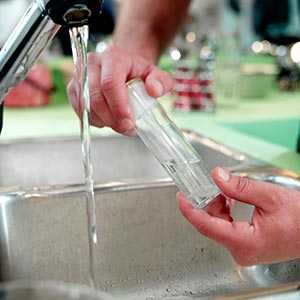Steps To Improve Drinking Water Programs
Strengthen your department’s drinking water program to protect people in your community whose drinking water comes from private wells.
Does Your Department Serve Areas That Rely on Wells or Other Private Sources for Drinking Water?

Water sample being taken from household tap water.
The majority (56%) of local health departments have programs to regulate, inspect, or license private drinking water sources in their community. Some private drinking water sources are not tested regularly for disease-causing contaminants (microbiological, chemical, and radiological). Without regular testing, people may be exposed to contaminants that can make them sick without knowing it or being able to do anything about it. By finding and addressing gaps in your program you can help reduce exposures in your community.
Where Do I Start?
Follow these steps to start improving your drinking water program. Using performance improvement tools may also help your agency prepare for and show documentation useful for public health accreditation.
- Familiarize yourself with the Environmental Public Health Performance Standards (EnvPHPS) to help you assess and improve your drinking water program’s ability to apply the 10 Essential Environmental Public Health Services.
- The EnvPHPS are a set of standards that describe the optimal performance and capacity for environmental public health systems and programs and aim to help make environmental public health programs and systems more effective.
- EnvPHPS can be used to assess agencies, systems, and programs such as drinking water programs.
- Complete the EnvPHPS assessment to identify gaps and strengths in your program. Our EnvPHPS Assessment Toolkit contains various resources you may find helpful to prepare for, conduct, and act upon the EnvPHPS assessment.
- Identify actions to help close gaps found in your assessment, such as actions outlined in our Logic Model for Drinking Water Programs. (Logic models show the relationship between a program’s activities and intended outcomes.)
- Change your drinking water program based upon your assessment results. Common actions include
- Improving communication about drinking water quality, water systems, and health data to the public and policymakers,
- Educating homeowners with private wells about testing practices,
- Supporting and advancing evidence-based policies, and
- Tailoring water treatment recommendations based upon test results.
You may want to explore our Tools and Promotional Materials from Grantees, which features videos, posters, and other tools from health departments working to reduce exposures from private wells.
- Page last reviewed: April 25, 2016
- Page last updated: April 25, 2016
- Content source:


 ShareCompartir
ShareCompartir